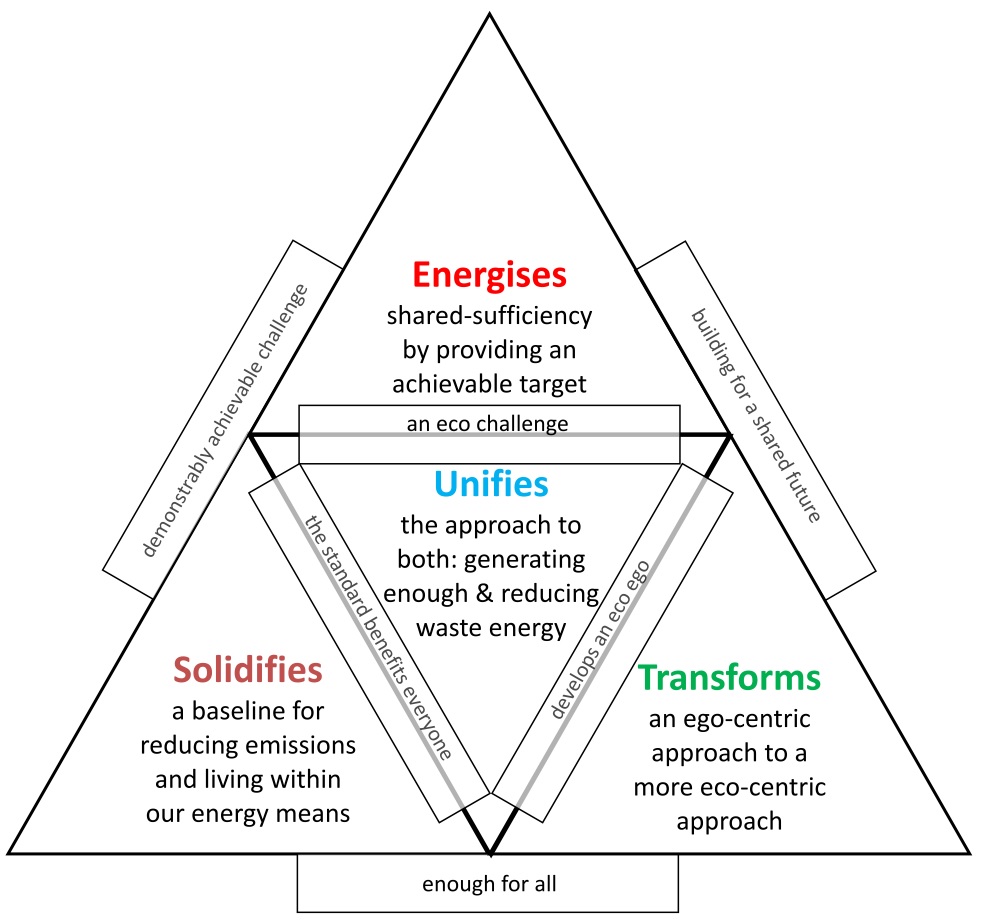Zero energy-source Emissions, NET 100% on-site energy generation/consumption
Avoid combustion to become Zero Emissions, and generate at least twice as much energy as you use on-site, to become Net100.
Why?
Why wait until 2030? Future-proof your building now!
We all need to:
- Reduce emissions from our own activities where we can.
- Generate our own energy and reduce network demand.
- Charge our own EVs, ideally without increasing network demand.
- Offset our embodied energy by generating more than we consume.
- Aim for shared-sufficiency.
It's achievable! Tanglewood is zero emissions, NET150+% energy (see below).
How
Design the building to fit the local environment and pay extra attention to insulation, ventilation, and energy efficiency. Expect to become more aware of weather and your energy consumption patterns so you can adapt the timing of your activities.
Replace any appliances/machines/heating/transport that are combustion based (eg gas, petrol, diesel biomass) with electric versions.
Measure annual energy:
- generated
- exported to the grid
- imported from the grid
- charging an EV (energy is consumed off-site)
- kWh generated onsite, divided by
- net kWh exported (charger + exported - imported),
- subtract the result from 1 (to convert net exported to net consumed)
- multiply by 100% (to get a percentage)
The Best Result Comes...
Tanglewood Footprint to Handprint

Comparing the electricity consumed, with the net contributed to the grid over the lifetime of our system, Tanglewood is NET 150+% energy!
Instead of consuming all its energy from the national grid, Tanglewood has contributed substantially which means more water left in the hydroelectric dams and less coal burned at peak times, TO THE BENEFIT OF EVERYONE... and the climate! Plus, it cumulatively compensates for the embodied energy (the significant amount of energy used to create the house, solar system, car etc in the first place).
Tanglewood's solar pv system is an interesting example of a handprint that's been challenging and fun to maximise. As pioneers, working with pioneers, it's important to ask, and ask again when the current best practice must be challenged. Almost daily, we find ways to reduce our energy consumption, PLUS giving even more to the grid (i.e. DOUBLE the benefit of making the effort). We're stretching out those fingers for a bigger handprint.
Daniel Goleman, Emotional Intelligence guru, offers an interesting take on why engaging people to act sustainably is so difficult. "We're engaging the wrong brain system." Talk of carbon-footprint taps into our brain's system of threat, fear, anger, depression and focuses on what we're doing wrong. The narratives around measuring and increasing our handprint is far more enticing, hopeful. It engages the reward system and what we're doing right!
| Tanglewood Handprint | Daniel Goleman Video |
|
|
|
Pioneering sustainability efforts often takes us to that uncomfortable part of our brain system...largely due to uncertainty. Below is an approach that we hope will help you focus on the positive and grow your handprint aiming beyond self-sufficiency to the new imperative for shared-sufficiency.
Tanglewood's Solar Energy in Practice
The metaphors of Nature illustrate the TetraMeme approach to eco-centric visioning and in this case the different levels of complexity and uncertainty.
 |
Earth - Best Practice Calculate the best angle for maximum energy production over a full year. (NB: that 'best' angle generates the least energy in winter when you need the most energy.) |
 |
Air - Logical Practice NIWA has calculated the average solar radiation every day of the year for a given place and solar panel angle, allowing for cloudy days and mountain shadows. For Tanglewood, 52 degrees is the best angle for the three months of winter. |
 |
Water - Relationship Practice When we discovered our solar system was struggling to cope with the demand from the heat pump hot water system, we persevered in questioning the wasted heat, trusted our designer and installer to come up with a solution, and they did! |
 |
Fire - Next Practice Where do you install solar panels out of sight at 52 degrees with easy access for cleaning? We designed them to hang in front of the deck balustrade. The elaborate, engineer-specified, cantelevered timber structure was a time & cost issue. We found an aluminium bracket that could be attached to the balustrade posts, and potentially adjusted twice a year for summer and winter angles. Our installer adjusted them first for summer and again for winter. The following summer, we lifted them back up to 30 degrees ourselves with a little help from our friends — thanks to Relationship Practice! |
- More on Handprinting from the International Living Future Institute.
- TetraMap: Building for a Living Future Case Study.
- My Big Shift by Jon about his overseas flights footprint.
- Gift 4 Nature project for grandkids.
- Tanglewood Solar Case Study.
- Tanglewood LBC Petal Certified

